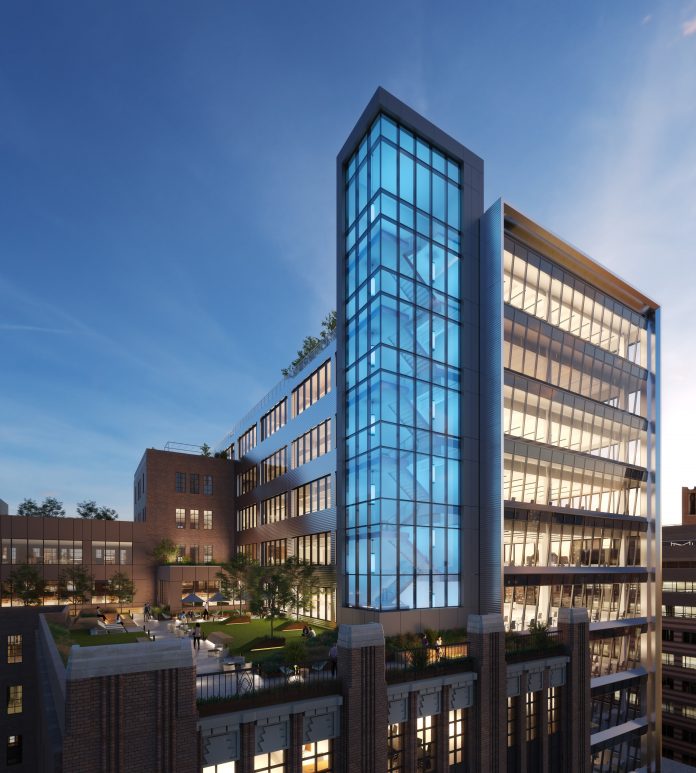Tishman Speyer CEO Rob Speyer has unveiled the firm’s plans and timetable for the development of The Wheeler, which the developer says will be a 10-story creative office hub to rise above Macy’s historic department store in the heart of Downtown Brooklyn.
The company says it will build a 620,000 sq. ft. vertical office campus spread across 10 floors and the project will be ready for occupancy in mid 2019.
“This new development in the heart of Brooklyn’s world-renowned cultural, residential and retail scene is made possible through an innovative redevelopment partnership between Macy’s and Tishman Speyer,” the news release says.
“For Tishman Speyer’s first-ever project in Brooklyn, we are creating an environment that is every bit as innovative, energetic and dynamic as the borough itself,” Speyer said in a statement. “The Wheeler will celebrate its special location at the epicenter of Brooklyn and feed off the vitality of the iconic brownstone neighborhoods, open spaces, cultural venues and creative communities that surround it on all sides.”
Architect Joey Shimoda, founder of the Shimoda Design Group, is designing the project with the architectural firm Perkins Eastman. This will be the first New York project for the Shimoda Design Group.
Tishman Speyer, which is serving as project developer and operating partner, is being joined by partner HNA Group, a China-based global investor. HNA is also an investment partner with Tishman Speyer on the firm’s two planned Hudson Yards development projects.
Construction financing, which was arranged by HFF, is being provided by Bank of the Ozarks.
Through the partnership between Macy’s and Tishman Speyer, Macy’s will continue to own and operate the first four shopping floors and lower level of two interconnected buildings – a nine-story art deco building built in 1930 and an adjacent four-story, cast-iron structure that was built by Andrew Wheeler in the 1870s.
Tishman Speyer is constructing 10 new office floors on top of the 1870s Wheeler building and says it will seamlessly integrate that new construction into the upper floors of the 1930 art deco building that Macy’s is vacating. The lower four office floors will encompass 90,000 sq. ft. of rentable space per floor, while the upper six office floors will range in size from 30,000 to 64,000 sq. ft.
Tishman Speyer is preserving all existing setbacks and creating a number of additional setbacks into the new construction. These setbacks, which will be spread out across eight offices floors, will be transformed into an acre of landscaped outdoor terraces and roof decks.
In addition to The Wheeler, Tishman Speyer recently began construction in Long Island City on two 27-story towers comprising 1.2 million sq. ft. of office space connected by a four-story, 43,000 sq. ft. retail podium. Across the street, Tishman Speyer is constructing three residential towers that will house approximately 1,900 rental apartments and 13,500 sq. ft. of retail space, along with a five-story, 50,000 sq. ft. amenity clubhouse and a private 1.5-acre park.
Last year, Tishman Speyer unveiled plans for The Spiral, a 2.85 million sq. ft. office tower to be developed at the intersection of the High Line and Hudson Park Blvd. on Manhattan’s far West Side. The developer also has assembled a second Hudson Yards development site adjacent to the new park and one block from the extended #7 subway line station, where it plans to construct a 1.3 million sq. ft. office tower.
“With each project, Tishman Speyer has set out to create the world’s most contemporary, collaborative workspaces,” Speyer said. “Our developments in Downtown Brooklyn, Long Island City and Hudson Yards reflect the new way that people are thinking about urban real estate and respond to their growing desire to work, live, shop, play and eat all within the same neighborhood.”
“The most exciting thing about modern day New York is the rapid emergence of these neighborhoods as viable 21st century business districts, which is key to the city’s ability to attract new industries and ensure that existing companies will have the space they need to grow here.”

